Adresse
Burgstraße 31
41516 Grevenbroich
Germany
Koordinate
51.1058783, 6.6179197553012
In the available literature there are references to the existence of Betsälen before the 19th century. Here, however, neither a more precise chronological classification nor a localization is possible. In 1818 the synagogue was established in the rear building of Burgstraß 31. In the course of the 19th century, the number of Jewish residents in Wevelinghoven remained constant. After the anti-Jewish riots in the wake of the so-called Xanten ritual murder affair in 1892, however, some members moved to the surrounding larger towns, so that the community began to shrink. In 1912 Ludwig Marx was the head of the congregation. After the end of the First World War, the congregation was so small that no minyan could be established. In 1921, therefore, the synagogue building was auctioned off in a restaurant. The new owners demolished the building after the end of the Second World War and built a residential house in its place. In the early 2000s, Helmut Coenen, together with fellow activists, installed a mosaic with a menorah on the sidewalk in front of the property. An information board mounted on a house wall near the mosaic had to be removed after persistent hostility and harassment.
Ereignisse
Epoche universalgeschichtlich
Beschreibung
Ludwig Marx is the head of the community
Epoche universalgeschichtlich
Beschreibung
The number of members of the congregation has fallen sharply, and as a result no minyan is formed.
Epoche universalgeschichtlich
Beschreibung
The building is auctioned off due to the too small congregation in a pub.
Epoche universalgeschichtlich
Beschreibung
The synagogue building is demolished. A residential building is erected in its place.
Epoche universalgeschichtlich
Beschreibung
Helmut Coenen, together with other active people, installs a mosaic in memory of the synagogue.
Epoche universalgeschichtlich
Literatur
Cames, H.; Herlitz, U.: Geschichte der Juden in Grevenbroich: Fragmente sieben jüdischer Gemeinden; Pfarrgemeinderat St. Peter und Paul, Grevenbroich, 1994.
Frinken, A.: Keine Blumen, sondern Steine: Die jüdischen Friedhöfe in Hemmerden, Hülchrath und Wevelinghoven als Gedenkorte in dörflichen niederrheinischen Kontexten; Köln, 2022 (Masterarbeit).
Pracht-Jörns, E.: Jüdisches Kulturerbe in Nordrhein-Westfalen: Teil II: Regierungsbezirk Düsseldorf; J.P. Bachem Verlag, Köln, 2000.
Ulrich Herlitz, Das Ende der jüdischen Gemeinde in Wevelinghoven. Die Zeit von 1933 - 1945, in: "Beiträge zur Geschichte der Stadt Grevenbroich", No.12/1996, hrg. vom Geschichtsverein für Grevenbroich und Umgebung, Grevenbroich 1996, S. 18 - 37
Redaktionell überprüft
Aus

Add new comment